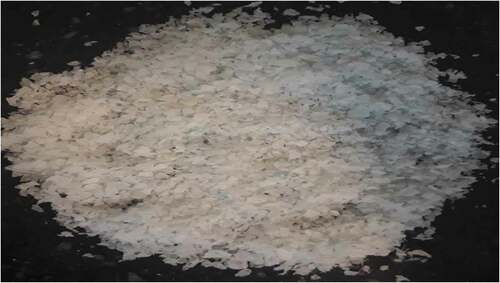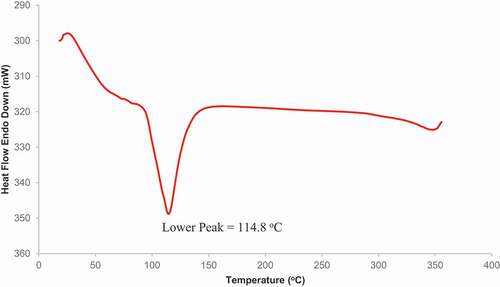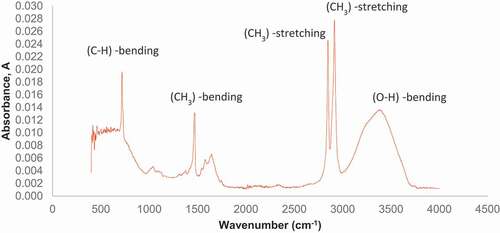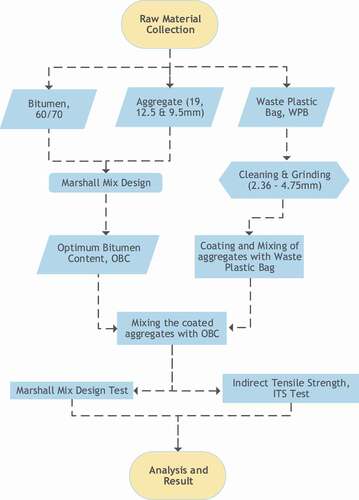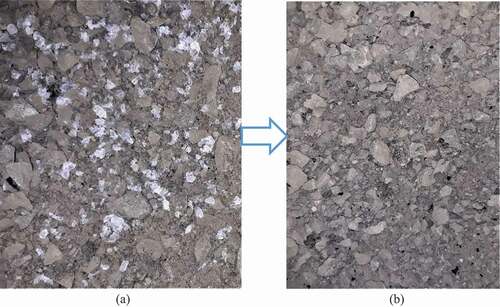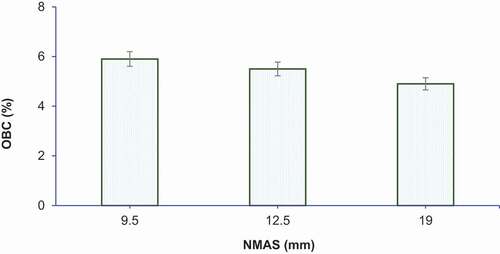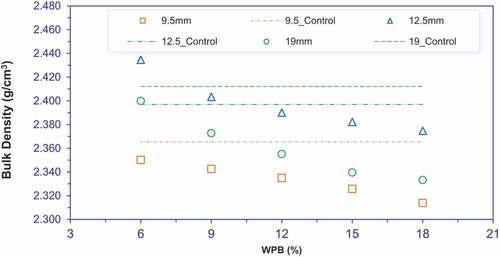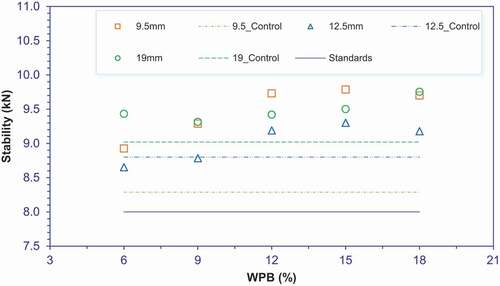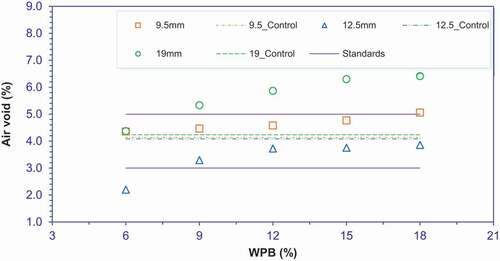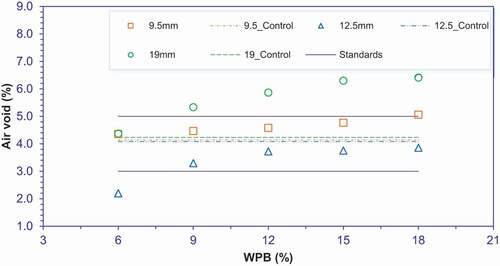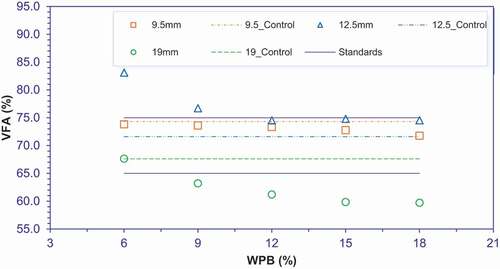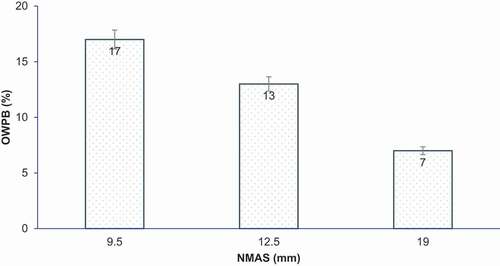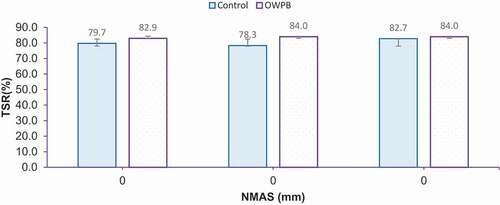 ?Mathematical formulae have been encoded as MathML and are displayed in this HTML version using MathJax in order to improve their display. Uncheck the box to turn MathJax off. This feature requires Javascript. Click on a formula to zoom.
?Mathematical formulae have been encoded as MathML and are displayed in this HTML version using MathJax in order to improve their display. Uncheck the box to turn MathJax off. This feature requires Javascript. Click on a formula to zoom.ABSTRACT
An increase in population with a tremendous growth rate, the disposal of large amounts of non-decaying waste materials becomes a great concern in developing and developed countries. Also, due to an increase in traffic volumes and loading repetitions, surface distress was observed in most of the asphalt roads. Therefore, recycling waste plastic into a new product is a solution. A cleaned, dried, and grind waste plastic bag is introduced to the asphalt mixture from 6–18% with a 3% increment by the weight of optimum bitumen content for each nominal maximum aggregate size. A total, 171 Marshall and indirect tensile strength samples were prepared. From the test result, the optimum waste plastic bag replacement of 17, 13, and 7% are obtained for 9.5, 12.5, and 19 mm nominal maximum aggregate sizes respectively. From the comprehensive experimental results, its concluded that asphalt mixtures mixed with the optimum amount of waste plastic bag, Marshall stability and tensile strength ratio results can increase on average by 8 % and 4 % respectively. Stability, flow, bulk density, voids, and moisture susceptibility results satisfy the Ethiopian Road Authority minimum specifications.
PUBLIC INTEREST STATEMENT
The rapid increase in the use of plastic materials in recent years led to the accumulation of extreme amounts of plastic waste and management of this waste is a major problem in Ethiopia. Therefore, one of the best solutions is recycling plastic waste for road construction. In this study, waste plastic bags are incorporated in the asphalt mixtures as an aggregate coating material and comprehensive laboratory experiments are conducted with varying the size of the aggregates (for the nominal maximum aggregate size 9.5,12.5 & 19 mm). Thus, in addition to the advantages from waste management, results showed that incorporating waste plastic bag, reduce bitumen consumption, gives better strength, and increase moisture sensitivity of the mix.
1 Introduction
Hot Mix Asphalt (HMA) pavements are the most predominant pavement type in Ethiopia. The government is also allocating a huge amount of budget to construct and upgrade the existing road networks nationwide. However, the increase in road traffic volume with an insufficient degree of maintenance has caused an accelerated and continuous deterioration of the road networks (Institute, Citation2009; Japan International Cooperation Agency, Citation2013). To alleviate this problem, several types of measures may be effective, for example, securing funds for maintenance, improved roadway design, use of better quality of materials, and the use of more effective construction methods.
On the other way, plastic is non-biodegradable material that will remain in the environment for hundreds of years leading to a waste disposal crisis as well as various environmental and health concerns. In Bahir Dar city about 27.6% of the generated municipal solid wastes are either burned or buried in their compound or disposed to lakesides (Lake Tana) or into the river (Abay) (UNEP (b), F. for E, Citation2010). Therefore, the plastic wastes that are not disposed of properly would enter Lake Tana and make it polluted. In a plastic waste stream, plastic bag waste constitutes a large proportion, which accounts for 92% by weight and 89.4% by volume and increased over time (Yehuala, Citation2007).
Globally, the plastic waste generation rate has been increasing and causing serious problems on the public health and ecosystem (Adela et al., Citation2020; Duggal et al., Citation2020; El-Maaty et al., Citation2020). Hence, there is a need for an innovative and sustainable approach, to use these growing quantities of plastic wastes (Giri et al., Citation2020). A lot of studies are going on efficient usage of this waste to convert it into wealth (Garg et al., Citation2020). Recycling or waste utilization in transportation construction industry is important for sustainability (Giri et al., Citation2020). This industry has a big range of different material uses so it can be the best way to recycle this waste into the construction of roads (Garg et al., Citation2020). Recycling plastics for road construction is a cost-effective approach along with eco-friendly disposal of plastic waste and used to mitigate the early deterioration of roads (Gade et al., Citation2019).
Plastic wastes incorporated in the asphalt mixes can be either by dry method or wet method, but different studies showed that the dry method is the most effective and is a better option as it is simple, economic, eco-friendly and yields better results (Mishra & Gupta, Citation2020).
Different scholars investigated the different types of plastic waste and its use for road construction. Depending upon their chemical composition and physical state, waste plastic for asphalt concrete production employed as a binder modifier (Duggal et al., Citation2020; Garg et al., Citation2020; Ponnada & Vamsi Krishna, Citation2020; Rohit Sai et al., Citation2018; Sheshachala et al., ; Shrivastava et al., Citation2019; Simha & Kumar, Citation2019; Singh & Chauhan, Citation2020); as an aggregates coat (Asare et al., Citation2019; Mishra & Gupta, Citation2018; Shah et al., Citation2018; Sharma et al., Citation2017); or used as a partial substitute portion of aggregates in the asphalt mix (Jafar, Citation2016; Xianglin, Citation2019).
Results were encouraging and exhibit an improvement in the performance of the modified asphalt mixes. Also, waste plastic can be used as a partial substitution of coarse aggregate in concrete mix (Adela et al., Citation2020). It can also be utilized in soil stabilization and results showed that plastic waste stabilization leads to an increase in bearing capacity, expressed in California bearing ratio (CBR) values, for low contents of plastic waste (Gardete & Luzia, Citation2020).
The use of waste plastic in recycled form, modified bitumen mix along with processed waste plastic of about 5–10% by weight of bitumen leads to a substantial improvement in the fatigue life, strength and other properties desirable in bituminous concrete (Duggal et al., Citation2020; Sheshachala et al.,). Similar studies (Ponnada & Vamsi Krishna, Citation2020) showed that replacing the bitumen with 7.5% of polyethylene plastic, improves the rheological properties, stability value and the maintenance period of the road and binding properties of bitumen can be modified by blending it with waste plastic pieces (Gawande, Citation2013).
In dense bituminous macadam mix, cleaned and shredded (2–3 mm) size Low Density Polyethylene (LDPE) and High-Density Polyethylene (HDPE) plastic waste from 2–5% and 1.5% additives (Zykotherm) by weight of optimum bitumen used and results on rheological and mix properties are best (Shrivastava et al., Citation2019). In another study, waste polymer replaced by bitumen in variation from 2–10% at an interval of 2% in dense bituminous macadam layer of flexible pavement investigated and 4–6 % of waste plastic in the mix had a good result compared to conventional mix (Garg et al., Citation2020). The binder prepared by mixing the waste plastic in 5–16% (by the weight of optimum bitumen) for bituminous macadam improved the characteristics of modified bitumen and bituminous mixes in general (Rohit Sai et al., Citation2018).
Due to the day-to-day increased axle load and traffic volume, results in deformation of flexible pavement, and when bitumen is mixed with plastic waste it improves the water resistivity, capacity and stability of the mix (Kumar & Khan, Citation2020; Simha & Kumar, Citation2019). Waste plastic, like polyethylene bags, bottles and crumb rubber combined with the bitumen grade 80/100, with waste plastic (3%, 5%, 7%, 9% and 11%) and crumb rubber (4%, 8%, 12%, 16%,20%) by the weight of bitumen can also improve the mix properties (Singh & Chauhan, Citation2020).
Plastic coated aggregate brought a better performance of flexible pavements (Kumar & Khan, Citation2020). Marshall specimens prepared at bitumen content ranging from 4% to 6% with an increment of 0.5% by weight of aggregates and with waste plastic content of 5%, 7%, 9%, 11%, 13% and 15% by weight of optimum bitumen content (Mishra & Gupta, Citation2018). LDPE and HDPE mixed as a modifier, added to the aggregate creating a thin film of coating on the aggregate surface (Shah et al., Citation2018). Asare and friends investigate the possibility of substituting about 10% of asphaltic road materials with plastic wastes as plastic coated aggregates (Asare et al., Citation2019).
Another way of incorporating plastic waste is the use of waste plastic as a partial aggregate replacement in bituminous mix products but often suffers from weak bonding between the plastic surface and the bitumen. Therefore, Chemical additives are used to improve the performance of the volumetric and mechanical properties of bituminous mixtures (Jafar, Citation2016). The stiffness increased by 10% for the chemically modified bituminous mixtures (Xianglin, Citation2019).
This research aims to study the possibility of using waste plastic bag (WPB) as an aggregate coat in HMA concrete mixtures varying the nominal maximum aggregate size (NMAS) through various laboratory experiments. Besides this, the effect of WPB replacement and optimum percentage replacement were studied. Comprehensive laboratory tests were conducted on the ingredient materials of the HMA concrete and all test results met the Ethiopian Road Authority (ERA, Citation2013) specifications.
2 Materials and methods
The raw materials like aggregate, bitumen, and WPBs are collected and properties of each material are studied in Bahir Dar University, Faculty of Civil and Water Resources Engineering and Ethiopian Institute of Textile (EiTEX) & Fashion Technology laboratories.
2.1 Aggregate
Physical characteristics of mineral aggregate and its suitability for road construction were evaluated and checked that satisfied the minimum Ethiopian Road Authority (ERA, Citation2013) standard requirements. Basalt rocks were used for this study since it is available in large quantities around the study area (Bahir Dar). shows the physical properties of mineral aggregates.
Table 1. Aggregate test results
shows the gradation curves plotted together for the three NMAS types. From the figure, it is easy to compare the percentage passing for each aggregate size and the particle size distribution requirements were checked and satisfied the minimum Ethiopian Road Authority (ERA, Citation2013) standard specification.
2.2 Asphalt binder
Asphalt binder 60/70 penetration from Iran was used for this research since most of the road projects around the study area were used this type of bitumen which is based on the observed site temperature. The properties of asphalt binder, which are presented in , are within the specification of asphalt grade 60/70.
Table 2. Asphalt binder test results
2.3 Waste Plastic Bag (WPB)
WPBs were collected from Ashraf industrial group PLC (water and oil factory) and shredded with a range between 2.36 mm and 4.75 mm size (Asare et al., Citation2019) as shown in . Processed WPBs were tested by using Differential Scanning Calorimetry (DSC) and Fourier Transform-Infrared Spectroscopy (FTIR) equipment at EiTEX and Fashion Technology laboratories. The results are as shown in respectively.
2.3.1 Differential Scanning Calorimetry (DSC)
DSC equipment is used to investigate the response of polymers to heating. The application of DSC test is to evaluate the thermal properties of the asphalt mixtures like waste plastic and bitumen materials (Kakar et al., Citation2019). From the DSC test result, the collected plastic bags are categorized under LDPE plastic material. DSC can be used to study the melting of a crystalline polymer or the glass transition. From the melting point of WPB determined from the DSC test is 114.8 °C. Based on the result, this WPB melts before the mixing temperature since the melting temperature is low. This is important for the better coating of the aggregates by this waste plastic.
2.3.2 Fourier Transform-Infrared Spectroscopy (FTIR)
Fourier Transform-Infrared Spectroscopy (FTIR) equipment is used to identify organic (and in some cases inorganic) materials. The chemical composition and characteristics of any material can be investigated by FTIR (Chang & Chu, Citation2019). It is a fast and accurate tool for detecting and analyzing asphalt materials at the molecular level, thus provide an opportunity for researchers to explore the asphalt chemical characteristics was initially introduced to study the asphalt material and it has been widely used (Hou et al., Citation2018). This technique measures the absorption of infrared radiation by the sample material versus wavelength. Absorbance is used to measure the amount of infrared radiation absorbed by a sample. The infrared absorption bands identify molecular components and structures. Functional groups/ molecular components of the organic and inorganic materials can be determined by using FTIR equipment. It has been increasingly used to investigate the impacts of oxidative aging on the chemical structure of bitumen (Hofko et al., Citation2017).
Therefore, for this study, the collected WPB functional groups are identified using FTIR equipment. From the test result, as shown in , this waste plastic material has molecular components of (C-H)–bending, (CH3)–bending, (CH3)–stretching, and (OH)-bending. But on polyethylene materials (OH)-bending is not expected, this may be due to the presence of some vegetable matters or proteins on the plastic surface. From works of literature, asphalt binders mostly consist of carbon and hydrogen, with a small amount of oxygen, sulfur, and several metals (Christopher et al., Citation2011). This WPB also has more or less comparative molecular components as bitumen. This helps to have an affinity (an attraction force between particles that causes to combine) between asphalt binder and WPB.
2.4 Experimental work
2.4.1 Experimental design
As shown in the experimental design in , compressive experimental studies are conducted to investigate the properties of asphalt mix, containing WPBs and to find out the appropriate plastic content of the mix. After evaluating the properties of bitumen, aggregates, and WPBs, blending of aggregate is carrying out and evaluated for the wearing course layer as per Ethiopian Road Authority (ERA, Citation2013) specification. Next, the optimum bitumen content was determined for the normal mixes (without WPBs), using the Marshall Mix design test. Similarly, another asphalt mix was prepared with the optimum bitumen content with varying percentages of waste plastic bag by the weight of optimum bitumen content. Lastly, Indirect Tensile Strength (ITS) test was conducted to evaluate the moisture susceptibility of modified asphalt mixes.
2.4.2 Marshall mix design and Indirect Tensile Strength (ITS) TEST
For both Marshall and ITS tests, as shown in , a total of 171 specimens were prepared, and from these 99 specimens are Marshall and the others are ITS specimens. After the conditioned/unconditioned ITS test conducted, the tensile strength ratio (TSR) values are calculated to express the numerical index or resistance of asphalt mixtures to the detrimental effect of water as the ratio of the original strength that is retained after conditioning (AASHTO T 283, and ASTM D4867).
Table 3. Number of test replicates in an experiment
Sample preparation, compaction and testing
As per AASHTO T 245, standard test method, an aggregate weighing about 1200 g is heated to a temperature of 165°C and 60/70 grade asphalt mixed to a temperature of 140–170°C. Next, specimens are compacted with a Marshall compactor for each NMAS by applying 75 standard blows on both faces, for the heavy loading design traffic categories. Marshall stability and flow test result are measured by using the Marshall stability and flow testing machine. In addition to this, volumetric properties (Va, Void in Mineral Aggregate (VMA), Void Filled with Asphalt (VFA)) are determined by bulk specific gravity (AASHTO T 166) and Theoretical Maximum Specific Gravity (AASHTO T 209) tests. Then, from the Marshall Hot Mix Design tests, the OBC was determined.
Likewise, another asphalt mix is compacted by mixing the OBC with varying percentages of WPBs (by the weight of OBC). The replacement rate of bitumen by the WPB was 6, 9, 12, 15, and 18% by the weight of OBC for the three (i.e, 9.5, 12.5 & 19 mm) aggregate sizes. Here also by adopting the Marshall Hot Mix Design procedure, 1200 g of aggregate that satisfied the grading requirement of Ethiopian Road Authority (ERA, Citation2013) specification was heated at a temperature of 165°C. Then, the processed/shredded waste plastic bags are evenly distributed ()) and mixed with the heated aggregate for about 2 minutes as shown in ()). Finally, the surface of the aggregate becomes coated with waste plastic bags.
Following that, by deducting the percent of added waste plastic bags from the OBC, the remaining amount of bitumen is mixed to a temperature of 140–170°C for about 2 minutes, and then the modified mix was ready for compaction. After the modified mix is compacted using Marshall compacter and tested following the same procedures (AASHTO T 245), the optimum waste plastic bag (OWPB) is determined for each NMAS.
Finally, ITS specimens were prepared with 0%, 3% below OWPB, at OWPB and 3 % above the OWPB, and then I have used AASHTO T 283 and ASTM D4867 test method for evaluating the moisture sensitivity of asphalt mixture.
mathematical equation for estimating the volumetric properties of modified mix
Due to the presence of a significant amount of waste plastic bags in the modified mixtures, the mathematical equation for estimating the volumetric properties of the modified mix is not the usual equation. Therefore, the following equations should be used to determine the volumetric properties of the modified mix (the mix incorporating waste plastic bag).
The air voids, Va, in a compacted mix is the volume of air between the coated aggregate particles. The bulk specific gravity test is used to determine the specific gravity (Gmb) of a compacted sample by determining the ratio of its weight to the weight of an equal volume of water. The theoretical maximum specific gravity test (Rice test) is used to determine the theoretical maximum specific gravity (Gmm) of asphalt mixture, which is the specific gravity excluding air voids. As usual, percent air void is typically calculated using Gmm and Gmb in the following Equationequation (1:)(1)
(1)
Where: Va = air voids in the compacted mix, percent of the total volume
Gmm = maximum specific gravity of mix
Gmb = bulk specific gravity of compacted mix
But there is an alternative procedure suggested by the Asphalt Institute because the precision of the test is best when the mixture is close to the design bitumen content. When these alternatives are used, Gmm calculated using the following equation (2:)
Where: Ps = aggregate content, percent by total weight of a mixture
Pb = bitumen content, percent by total weight of a mixture
POWPB = optimum waste plastic bag content, percent by weight of OBC
Gse = effective specific gravity of aggregate
Gb = specific gravity of bitumen
GWPB = specific gravity of the waste plastic bag
All the other volumetric properties of the mixtures like VMA and VFA are estimated by using the general or usual mathematical equations(Institute, Citation2009).
3 Result and discussion
3.1 OBC determination
Using Marshall Hot Mix Design procedures Marshall specimens were prepared and tested for 9.5, 12.5 and 19 mm NMAS and evaluated with (ERA, Citation2013) standard specification.
As shown in , the OBC decreases through increasing the NMAS. This is because decreasing the nominal aggregate size will increase the surface area of the aggregate. Due to this large amount of bitumen is required to coat the whole surface area of aggregate. Secondly, the aggregate can resist the majority of the imposed load, when the aggregate size is large comparing the smaller size of the aggregate. Therefore, the aggregate having a smaller size needs a lot of binders to resist the incoming load as specified in MS-2 (Asphalt Institute, Citation2009). Due to the above reasons, the OBC decreases with increasing the nominal aggregate sizes of the aggregate.
3.2 marshall properties of asphalt mixtures containing WPB
Effect of WPB on bulk density
presents the bulk density of the modified asphalt concrete mixtures for all NMAS types. The bulk density of compacted asphalt mix slightly decreases with an increase in the WPB replacement rate, and similar for all NMAS types (Abd Kader et al., Citation2017). This is due to the relatively low density of WPB comparing to the density of bitumen. In addition to this, increasing %WPB replacement produces thicker WPB layers around the individual aggregates and tends to push the aggregate particles further apart subsequently resulting in a lower density.
Comparing the modified asphalt mix with the control except for 12.5 mm in all types of NMAS and percentage replacement of WPB, the bulk density of the modified asphalt mix is lower than the control asphalt mix. This may be due to the better aggregate interlocking behavior of 12.5 mm NMAS comparing to the others.
Effect of WPB on flow
shows the flow of the modified asphalt concrete mixtures for 9.5, 12.5, and 19 mm NMAS. In all types of NMAS, flow decreases as increasing the WPB content (Abd Kader et al., Citation2017) by weight of OBC, until it reaches the lowest value, and then increases with increasing the %WPB replacement. Other studies concluded that the flow was increased by adding plastic waste to the asphalt mixture (Badejo et al., Citation2017). The flow of modified asphalt concrete decreases as WPB replacement rate become approximately up to 12% (for 9.5 & 19 mm NMAS) and 15% for 12.5 mm NMAS.
This could be due to the resilience/ toughness properties of WPB comparing to the asphalt binder. But when the %WPB replacement increases beyond this, because of the excess amount of WPB contents are coating the aggregate, the flow starts to increase (Asare et al., Citation2019). Asphalt mix modified with higher percentages of WPB exhibits higher flow and may not satisfy the minimum specifications.
Effect of WPB on stability
indicates the stability of the modified asphalt concrete mixtures for 9.5, 12.5, and 19 mm NMAS types. The stability graph for the modified asphalt concrete mixtures having NMAS of 9.5 and 12.5 mm, shows a similar trend that the stability increases as the %WPB replacement increases until it reaches the peak and goes down. This is due to the toughness properties of WPB, %WPB replacement to a certain extent (15% WPB replacement) modifies the mix and increases stability. After that due to the reduction of bitumen which is replaced by WPB and additional/excess coating of aggregate by WPB tends to separate aggregate interlock and hence, the mix becomes loose and reduces the stability (Abd Kader et al., Citation2017; Asare et al., Citation2019).
But in the case of NMAS of 19 mm stability slightly decrease at the beginning and then increases as increasing of %WPB replacement. To determine the maximum stability for 19 mm NMAS further replacement of %WPB requires. But since the other parameters like air void and VFA were not met both the local and international specifications, further replacement of %WPB is meaningless.
In general, the asphalt mixes containing recycled WPBs can improve the stability/stiffness of the mixtures (Singhal et al., Citation2016).
Effect of WPB on air void
Asphalt mix modified with higher percentages of WPB exhibit higher air voids. Comparing to the other, modified asphalt mix having 19 mm has a higher air void () because the WPB can easily coat the fine aggregates and may not create a proper bond (by coating) between the large aggregates, results in asphalt concrete become lose and hence increase the air void.
Adding WPB into the asphalt mixture reduces the bulk density of the mixture due to the lower density of WPB compared to asphalt and aggregate as discussed previously. WPB has also plastic behaviour thus resists compaction efforts and condensing of the mixture. As a result, and similar study assures that, increasing %WPB replacement increases the air void of asphalt mixture (Badejo et al., Citation2017; Hake et al., Citation2020).
Effect of WPB on VMA
shows the VMA of modified asphalt concrete mixtures using NMAS types of 9.5, 12.5, and 19 mm. Percentage VMA of modified asphalt concrete mixture increases in each of NMAS with an increasing rate of %WPB replacement. VMA depends on the bulk density of asphalt concrete, percentage bitumen content, and the specific gravity of the aggregate used. Here referring to , the bulk density for all types of NMAS decreases as %WPB replacement increases. Decreasing bulk density will result in increasing VMA. Therefore, as %WPB replacement increases, VMA also increases since the density of WPB is the lowest comparing with each component of the mixtures. Different studies confirmed higher VMA values for all plastic waste percentages used in modified mixture compared to VMA values in control samples (Taherkhani & Arshadi, Citation2019).
When VMA is too low, there is not enough room in the mixture to add sufficient asphalt binder to adequately coat the individual aggregate particles. Excessive VMA will also cause unacceptable low mixture stability (Roberts et al., Citation1996). Due to this, results in this study showed, the stability decreases with excess VMA content.
Effect of WPB on VFA
presents the VFA of modified asphalt concrete mixtures using NMAS types of 9.5, 12.5, and 19 mm. Asphalt concrete prepared with all types of NMAS has the same trend that the percentage of VFA steadily decreases with increasing %WPB replacement. Like other volumetric analyses, VFA also depends on VMA and air void. Therefore, the effect shown on the VMA and air void has also influence VFA. As shown in , the portion of air void increases as increasing %WPB replacement. Similarly, VMA slightly increases as %WPB replacement increases (). Therefore, VFA of the asphalt mixtures decreases as increasing % WPB replacement (Abd Kader et al., Citation2017).
The decrease of VFA indicates a decrease of effective asphalt film thickness between aggregates, which will result in higher low-temperature cracking and lower durability of asphalt mixture since asphalts perform the filling and healing effects to improve the flexibility of the mixture (Asphalt Institute, Citation2009). Therefore, high %WPB replacement is not recommended.
3.3 Optimum WPB content determination
The optimum WPB content is selected as the content that satisfies the minimum air void percent or the closest percentage to air void content of 4%. Based on this, as much as possible for each NMAS types the optimum WPB content which can satisfy the (ERA, Citation2013) standard specifications were selected.
As plotted in from the Marshall method of mix design, the optimum %WPB replacement contents for 9.5, 12.5, and 19 mm NMAS types are 17, 13, and 7 % by weight of OBC respectively. From the graph, WPB content decreases with increasing the NMAS. From the result, it is possible to conclude that the OWPB content depends on the type of NMAS. Because comparatively 9.5 mm NMAS surface area of the aggregate is too large and it needs more WPB for coating and bitumen contents are also replaced by the same percentage of WPB.
showed the standards and the resulting measured values for the optimum %WPB replacement contents for 9.5, 12.5 and 19 mm NMAS types
Table 4. Summary of marshall hot mix design results at the optimum %WPB replacement
4 Tensile Strength Ratio (TSR)
According to (Asphalt Institute, Citation2009), a TSR value of 0.80 (80 %) or greater is generally considered acceptable, indicating an asphalt mixture that is not vulnerable to moisture damage. Since moisture damage is one of the most driving factors for pavement distress, evaluating the water resistance of asphalt mixture is a very important task.
As shown in , the TSR of asphalt concrete mixtures at the optimum WPB content for 9.5, 12.5 & 19 mm NMAS are 82.9, 84 & 84% and for control specimen are 79.7, 78.3 & 82.7% respectively. This shows that the TSR values for all types of NMAS at the optimum WPB replacement rate are greater than 80%. Therefore, the asphalt concrete mixture modified with optimum WPB replacement is not prone to moisture damage (El-Maaty et al., Citation2020; Giri et al., Citation2020; Taherkhani & Arshadi, Citation2019). This is because WPB creates an adhesive bond between aggregate and asphalt, this leads to reducing stripping and ravelling problems (Shah et al., Citation2018). Plastic modified asphalt mixture shows better water resistant or moisture damages (Singhal et al., Citation2016).
5 Statistical analysis
The numbers in the , F and p-values are analysis of variance (ANOVA) test results. The F-value in the ANOVA test is used to determine the p-value. The p-value (Sig.) is used to check whether or not the aggregate size (NMAS), %WPB or the interaction of both affects the parameters of asphalt mixtures (like stability, flow, and voids).
Table 5. ANOVA analysis on tests of b/n subject’s effects
ANOVA test is performed to verify or reject the null hypothesis and to check the experimental results are statically significant or not (Rondón-Quintana et al., Citation2018). ANOVA analysis as shown in , bulk density, air void, VMA, and VFA are statistically significant in both WPB replacement, varying NMAS, and interaction effects (WPB * NMAS) at the level of α = 0.05 or 95%. This implies that WPB replacement, varying NMAS, and the interaction of the two affect the bulk density, air void, VMA, and VFA of the asphalt concrete. Similarly, varying NMAS and WPB replacement are statistically significant on flow and stability respectively. But WPB replacement & interaction effects on flow and varying NMAS & interaction effects on stability are not statistically significant. Likewise, the statistical analysis also confirms the above-mentioned result discussions.
6 Conclusions
The essence of this work is to study the application of WPB by incorporating it in to the asphalt mixture. The result showed that incorporating this waste improve the stability and stiffness of the mix and it is environmentally friendly.
As shown from the experimental result, as percentage WPB replacement increases, result of Marshall stability is greater than the control specimen. Asphalt mix modified with WPB replacement shows lower bulk density & VFA; and higher flow, air void & VMA. But the stiffness of the modified mix is increased by approximately up to 15% replacement. This decrease in bulk density can be explained to be a result of the low density of added plastic material. From Marshall Hot Mix Design, the optimum WPB replacement content of 17, 13, and 7% got for 9.5, 12.5 & 19 mm NMAS respectively. With this optimum WPB, all the other Marshall properties (like stability, flow, air void, VMA & VFA) met Ethiopian Road Authority specifications (ERA, Citation2013). Therefore, the modified mix having 9.5 & 12.5 mm size of aggregate are suitable for wearing coarse and 19 mm for binder coarse layer. For all NMAS, TSR result at the optimum WPB replacement are greater than 80%, which indicates the modified mix is not vulnerable to moisture damage.
Generally, for flexible pavement road construction, incorporating waste plastic bags in the mix is economically viable in terms of cost reduction by decreasing bitumen consumption and creating of eco-friendly environment. Quantitative economic analysis considering different factors and indirect costs like landfill cost, cost of construction and maintenance & rehabilitation cost; conducting performance-based tests (like rutting & fatigue) are recommended for future studies.
Acknowledgements
The authorwould like to acknowledge the research advisor, Dr. Habtamu Melese (PhD, PE), for his unlimited support, guidance and valuable comments during the research work.
Disclosure statement
The authors declare no competing interests.
Additional information
Funding
Notes on contributors
Nakachew Assefa
Nakachew Assefa is a lecturer at the Faculty of Civil & Water Resources Engineering, Bahir Dar Institute of Technology, Bahir Dar University. He obtained his first (BSc.) degree in Civil Engineering and his second (MSc.) degrees in Road and Transport Engineering from Bahir Dar University.
References
- Abd Kader, S. A., Putra Jaya, R., Yaacob, H., Hainin, M. R., Abdul Hassan, N., Wan Ibrahim, M. H., & Ali Mohamed, A. (2017). Stability and volumetric properties of asphalt mixture containing waste plastic. MATEC Web of Conferences, 103, 09002. https://doi.org/https://doi.org/10.1051/matecconf/201710309002
- Adela, Y., Berhanu, M., & Gobena, B. (2020). Plastic wastes as a raw material in the concrete mix : An alternative approach to manage plastic wastes in developing countries. International Journal of Waste Resources10, 382. https://doi.org/https://doi.org/10.35248/2252-5211.20.10.382
- Asare, P. N. A., Kuranchie, F. A., Ofosu, E. A., & Verones, F. (2019). Evaluation of incorporating plastic wastes into asphalt materials for road construction in Ghana. Cogent Environmental Science, 5(1), 1576373. https://doi.org/https://doi.org/10.1080/23311843.2019.1576373
- Badejo, A. A., Adekunle, A. A., Adekoya, O. O., Ndambuki, J. M., Kupolati, K. W., Bada, B. S., & Omole, D. O. (2017). Plastic waste as strength modifiers in asphalt for a sustainable environment. African Journal of Science, Technology, Innovation and Development, 9(2), 173–177. https://doi.org/https://doi.org/10.1080/20421338.2017.1302681
- Chang, Z., & Chu, M. (2019). The chemical composition and pyrolysis characteristics of thermal bitumen derived from pyrolyzing huadian oil shale, China. Oil Shale, 36(1), 62. https://doi.org/https://doi.org/10.3176/oil.2019.1.05
- Christopher, W. J., Crawford, F. J., Edward, T. H., Adock, M., Delaney, E. P., & Freer, H. (2011). A manual for design of hot mix asphalt with commentary. NCHRP Report No. 673. In Transportation Research Board.
- Duggal, P., Shisodia, A. S., Havelia, S., & Jolly, K. (2020). Use of waste plastic in wearing course of flexible pavement. In Advances in Structural Engineering and Rehabilitation.177-187. https://doi.org/https://doi.org/10.1007/978-981-13-7615-3_16. Springer, Singapore.
- El-Maaty, A. E. A., Sourour, I. R. I., & Bekheet, W. A. E. S. (2020). Using of plastic wastes as additives in bituminous mixes. Applied Science and Engineering Progress, 14(1), 131–141. https://doi.org/https://doi.org/10.14416/J.ASEP.2020.11.003
- ERA. (2013). Pavement Design Manual, VOLUME 1 FLEXIBLE PAVEMENTS. Roads Authority Ethiopian. https://www.academia.edu/29921294/THE_FEDERAL_DEMOCRATIC_REPUBLIC_OF_ETHIOPIAN_ROADS_AUTHORITY_2013_PAVEMENT_DESIGN_MANUAL_VOLUME_I_FLEXIBLE_PAVEMENTS
- Gade, A., Kulkarni, S., Tapase, A., & Bonde, S. (2019). A cost-effective approach towards road construction—kondave a case study. Sustainable Civil Infrastructures, 98–106. https://doi.org/https://doi.org/10.1007/978-3-319-95759-3_8
- Gardete, D., & Luzia, R. (2020). Experimental study on soils stabilized with two types of plastic waste. KnE Engineering, 40–50. https://doi.org/https://doi.org/10.18502/keg.v5i6.7020
- Garg, A., Somani, P., Gaur, A., & Swami, B. L. (2020). Gainful utilization of plastic waste in dense bituminous macadam. IOP Conference Series: Materials Science and Engineering. https://doi.org/https://doi.org/10.1088/1757-899X/872/1/012129. IOP Publishing.
- Gawande, A. P. (2013). Economics and viability of plastic road : A review. Chem. Pharm. Sc, 3(4), 231–242. http://www.sadgurupublications.com
- Giri, J. P., Panda, M., & Sahoo, U. C. (2020). Use of waste polyethylene for modification of bituminous paving mixes containing recycled concrete aggregates. Road Materials and Pavement Design, 21(2), 289–309. https://doi.org/https://doi.org/10.1080/14680629.2018.1487873
- Hake, S. L., Damgir, R. M., & Awsarmal, P. R. (2020). Utilization of plastic waste in bitumen mixes for flexible pavement. Transportation Research Procedia, 48, 3779–15. https://doi.org/https://doi.org/10.1016/j.trpro.2020.08.041
- Hofko, B., Alavi, M. Z., Grothe, H., Jones, D., & Harvey, J. (2017). Repeatability and sensitivity of FTIR ATR spectral analysis methods for bituminous binders. Materials and Structures/Materiaux Et Constructions,50(3), 1–15. https://doi.org/https://doi.org/10.1617/s11527-017-1059-x
- Hou, X., Lv, S., Chen, Z., & Xiao, F. (2018). Applications of Fourier transform infrared spectroscopy technologies on asphalt materials. In Measurement: Journal of the international measurement confederation, 121, 304–316. https://doi.org/https://doi.org/10.1016/j.measurement.2018.03.001
- Institute, A. (2015). Asphalt Mix Design Methods MS-2 (7th Edition). In ASTM International. Asphalt Institute.
- Jafar, J. J. (2016). Utilisation of waste plastic in bituminous mix for improved performance of roads. KSCE Journal of Civil Engineering, 20(1), 243–249. https://doi.org/https://doi.org/10.1007/s12205-015-0511-0
- Japan International Cooperation Agency. (2013). Basic research for improvement of road development projects by Japan’s ODA in African Countries - Ethiopia, Ghana, Tanzania (Issue March).
- Kakar, M. R., Refaa, Z., Worlitschek, J., Stamatiou, A., Partl, M. N., & Bueno, M. (2019). Thermal and rheological characterization of bitumen modified with microencapsulated phase change materials. Construction and Building Materials, 215, 171–179. https://doi.org/https://doi.org/10.1016/j.conbuildmat.2019.04.171
- Kumar, R., & Khan, M. A. (2020). Use of plastic waste along with bitumen in construction of flexible pavements. International Journal of Engineering Research And Technology, 9(3), 153–158. https://doi.org/https://doi.org/10.17577/ijertv9is030069
- Mishra, B., & Gupta, M. K. (2018). A study on use of plastic coated aggregates (PCA) in bituminous concrete mixes of flexible pavement. International Journal of Engineering and Technology(UAE) , 7(4.5), 396–401. https://doi.org/https://doi.org/10.14419/ijet.v7i4.5.20191
- Mishra, B., & Gupta, M. K. (2020). Use of plastic waste in bituminous mixes by wet and dry methods. Proceedings of the Institution of Civil Engineers: Municipal Engineer, 173(2), 87–97. https://doi.org/https://doi.org/10.1680/jmuen.18.00014
- Ponnada, S., & Vamsi Krishna, K. (2020). Experimental investigation on modification of rheological parameters of bitumen by using waste plastic bottles. Materials Today: Proceedings, 32, 692–697. https://doi.org/https://doi.org/10.1016/j.matpr.2020.03.243
- Roberts, F. L., Kandahal, P. S., Brown, R. E., Lee, D.-Y., & Kennedy, T. W. (1996). Hot mix asphalt material mixture, design and construction (Second Edi). National Asphalt Pavement Association Research and Education Foundation.
- Rohit Sai, E., Venkata Ratnavali, K., Satish Chandra, D., & Asadi, S. S. (2018). Waste plastic utilization in butuminous mix for replacement of binder - a model study. International Journal of Civil Engineering and Technology, 9(5), 475–486. https://iaeme.com/Home/issue/IJCIET?Volume=9&Issue=5
- Rondón-Quintana, H. A., Ruge-Cárdenas, J. C., Patiño-Sánchez, D. F., Vacca-Gamez, H. A., Reyes-Lizcano, F. A., & de Farias, M. (2018). Blast furnace slag as a substitute for the fine fraction of aggregates in an asphalt mixture. Journal of Materials in Civil Engineering, 30(10), 04018244. https://doi.org/https://doi.org/10.1061/(ASCE)MT.1943-5533.0002409
- Shah, S. M. R., Zainuddin, N. I., Tutur, N., Ismail, S., Sian, T. L., & Nasaruddin, N. A. I. (2018). Strength properties of polyethylene in bituminous mixtures for flexible pavement. AIP Conference Proceedings, 2031(1), 020029. https://doi.org/https://doi.org/10.1063/1.5066985. AIP Publishing LLC.
- Sharma, M., Trivedi, A. S., & Sahu, R. (2017). Pavement evaluation studies on low volume roads using plastic coated aggregate and bituminous mix. International Journal of Applied Environmental Sciences , 12(5), 973–6077. http://www.ripublication.com
- Shrivastava, V., Nema, A., Kushwaha, P. K., & Shrivastava, S. (2019). Formulation of modified dense graded bituminous macadam with low density and high density polythene with zykotherm admixture. Smart Moves Journal Ijoscience, 5(5), 9. https://doi.org/https://doi.org/10.24113/ijoscience.v5i5.203
- Simha, S., & Kumar, L. (2019). Use of plastic waste in flexible pavement construction. Open Access International Journal of Science and Engineering, 2 (10), 107–110. 2456-3293. http://www.oaijse.com
- Singh, G., & Chauhan, R. (2020). Experimental study on the behaviour of modified bituminous concrete mix developed using plastic waste and scrapped rubber tyre. International Journal of Advanced Science and Technology, 29(6),1621–1630. http://sersc.org/journals/index.php/IJAST/article/view/12104
- Singhal, M., Yadav, Y., & Mandal, R. (2016). Use of modified bitumen in highway construction. International Journal for Innovative Research in Science & Technology, 2(12), 2349–6010. http://www.ijirst.org
- Taherkhani, H., & Arshadi, M. R. (2019). Investigating the mechanical properties of asphalt concrete containing waste polyethylene terephthalate. Road Materials and Pavement Design, 20(2), 381–398. https://doi.org/https://doi.org/10.1080/14680629.2017.1395354
- UNEP (b), F. for E. (2010). Assessment of the solid waste management system of bahir dar town and the gaps identified for the development of an (Issue June).
- Xianglin. (2019). Performance improvisation of bituminous roads using waste plastic material. International Journal of Civil, Environmental and Agricultural Engineering, 1(1), 54–61. https://doi.org/https://doi.org/10.34256/ijceae1918
- Yehuala, A. (2007). Plastic Bag Waste Generation Rate in Bahir Dar Town (Doctoral dissertation, Addis Ababa University). http://thesisbank.jhia.ac.ke/id/eprint/4052

